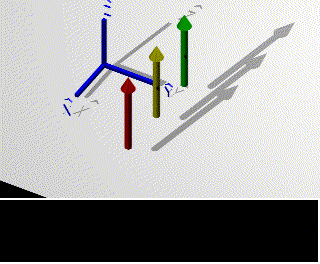This is page is a demonstration of Nuclear Magnetic Resonance spectroscopy or NMR. Imagine the nuclie of three hydrogen attoms in a uniform magnetic field that is pointing in the z direction. The magnetic moments of the nuclei of these three atoms are represented by colored arrows. In the beginning the magnetic moments are all alinged with the magnetic field. A radio frequency (rf) field that is circularly polarized in the x-y plane is then briefly applied to the protons. The frequency of the rf pulse is choosen to be the Larmor frequency. (This frequncy is propotional to the magnetic field strength and the gryomagnetic ratio of the nuclei.) The effect of the rf pulse is to rotate the nuclei about an axis in the x-y plane by an amount proportional to the time of the pulse. At first the length of the pulse is chosen so that the nuclie rotate by 90 degrees or pi/2 radians. This places them in the x-y plane. This pulse is called (for obvious reasons) the pi/2 pulse. The nuclie will now precess about the static field at the Larmor frequency until they once again align themselves with the static magnetic field. The precesion of the nuclie creates rf emission which is picked up by a sensitive reciever.

The magnetic field produced by a real magnet is not entirely uniform. This means that some of the nuclie will precess at slightly different frequencies depending on the strength of the magnetic field. Over time the precessing nuclie will "fan out" in the x-y plane and the strength of the rf signal will thus decay. In the animation the red arrow represents a nucleus that is in a magnetic field slightly less than the average so it will precess slightly slower than average. The yellow arrow represents a nucleus in an average field. In the animation the frame of reference is rotating about the z-axis at the Larmor frequency, so the yellow arrow (which is precessing at the rate of the Larmor frequency) appears stationary in this frame. The green arrow represents a nuclues in a slightly higher field which will precess slightly faster.
The signal can be recovered by the application of another cicularly polarized magnetic field that is timed to rotate the magnetic moments about an axis in the x-y plane by 180 degrees or pi radians. This is refered to as the pi pulse. In the annimation the pi pulse happens when the arrows suddenly "jump" from pointing in the negative y direction to the positive y direction. (This is a third of the way through the loop.) If you watch closely you can observe that the nuclie that were traveling slower and got behind the others are now ahead, but still traveling slower. The nuclie that were precessing too fast and got ahead are now behind, but still precessing faster. The amplitude of the signal increases as all the individual moments realign themselves. The signal now recovers itself! This is the spin echo. The signal once again decays as the moments once again start to fan out due to their slightly different precession rates.
See Rotating Coordinate Systems